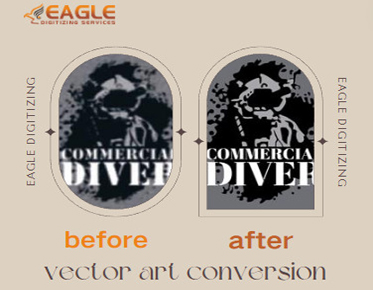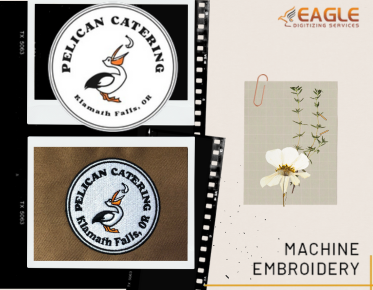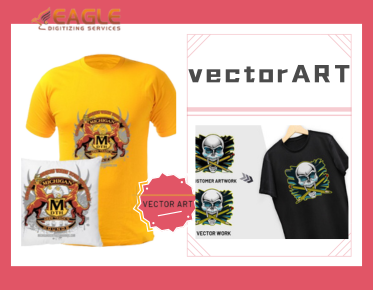The Timeless Craft of Silk Screen and Screen Printing/Eagle Digitizing
Silkscreen and screen printing have been cherished artistic and commercial practices for centuries. From ancient textile traditions to modern graphic design, these methods have transcended time, continuously evolving to meet the needs of various industries. Whether you're a seasoned artist or a curious novice, understanding the nuances of these printing techniques can open up a world of creative possibilities.
History
of Silk Screen and Screen Printing
The Origins of Silk Screen
Printing
Silk screen printing, also known as serigraphy, dates back to
ancient China during the Song Dynasty (960-1279 AD). Artisans used silk mesh to
create intricate patterns on fabrics, a practice that soon spread to Japan and
other parts of Asia. This early form of screen printing laid the groundwork for
the modern techniques we use today.
Evolution of Screen Printing
Over the Years
As the centuries progressed, silk screen printing evolved, with significant advancements occurring in the 20th century. The introduction of synthetic materials and photographic stencils revolutionized the process, making it more accessible and versatile. Today, screen printing is used in everything from fine art to industrial applications, showcasing its enduring relevance.
Basic
Principles of Silk Screen Printing
How Silk Screen Printing Works
Silk screen printing begins with the creation of a stencil (or
screen), which is then used to apply layers of ink to a substrate. The process
begins with preparing a screen coated with a light-sensitive emulsion. Once
exposed to light, the emulsion hardens, leaving a negative image of the design.
Ink is then pushed through the screen onto the substrate, transferring the
design.
Key Materials Used in Silk
Screen Printing
Silk screen printing relies on a few essential materials: a screen (traditionally made of silk but now often polyester), ink, a squeegee, and a substrate (such as fabric, paper, or plastic). Each material plays a crucial role in ensuring the quality and precision of the final print.
Understanding
Screen Printing
The Fundamentals of Screen Printing
Screen printing, while similar to silk screen printing,
encompasses a broader range of techniques and materials. The fundamental
principle remains the same: forcing ink through a stenciled mesh screen to
create a design on the surface below. This method is celebrated for its ability
to produce vibrant, durable prints on various substrates.
Essential Equipment for Screen
Printing
Key equipment for screen printing includes the screen frame, emulsion, exposure unit, ink, and squeegee. Modern advancements have introduced automated screen printing machines, enhancing efficiency and precision for large-scale production.
Silk
Screen vs. Screen Print: Are They the Same?
Common Misconceptions Explained
While often used interchangeably, silkscreen and screen printing have
nuanced differences. Silk screen printing specifically refers to the
traditional method using silk mesh, whereas screen printing is a more general
term that includes various techniques and materials. Understanding this
distinction can help clarify common misconceptions.
Breaking Down the Terminology
In essence, silk screen printing is a subset of screen printing. The terminology can vary depending on context, but the core principles remain consistent. Whether you're using silk or synthetic mesh, the process and its artistic potential are remarkably similar.
The
Art of Silk Screen Printing
Crafting the Perfect Design
Creating a successful silk screen print starts with a compelling
design. Artists often use graphic software to refine their ideas before
transferring them to the screen. Precision is key, as any flaws in the stencil
can affect the final print.
The Role of the Stencil in Silk
Screen Printing
The stencil is the heart of silk screen printing. Traditionally created using a photo-emulsion process, stencils allow for intricate and repeatable designs. Mastering stencil creation is essential for achieving high-quality prints.
The
Science Behind Screen Printing
The Process of Creating a Screen
Print
Screen printing involves several precise steps: preparing the screen,
applying emulsion, exposing the screen to light, washing out the stencil, and
finally, printing. Each step requires careful attention to detail to ensure a
flawless result.
The Importance of Mesh Count
Mesh count refers to the number of threads per inch on the screen. It plays a critical role in determining the print’s detail and ink thickness. Higher mesh counts are ideal for fine details, while lower counts allow for thicker ink layers.
Differences
in Techniques
How Silk Screen and Screen Print
Differ in Application
Silk screen printing is often preferred for artistic and
limited-edition prints due to its handcrafted nature. In contrast, screen
printing is widely used in commercial and industrial applications for its
scalability and efficiency.
Unique Methods in Each Process
Silk screen printing emphasizes artisanal techniques, often involving manual processes that add a unique touch to each print. Screen printing, on the other hand, leverages technological advancements to enhance precision and consistency.
Materials
and Inks
Types of Inks Used in Silk
Screen Printing
Silk screen printing traditionally uses inks like plastisol,
water-based, and discharge inks. Each type offers distinct characteristics,
from vibrant colors to soft finishes, allowing artists to choose the best fit
for their projects.
Exploring Different Inks for
Screen Printing
Modern screen printing explores a vast array of inks, including specialty inks like metallic, puff, and UV-reactive inks. These innovations enable diverse applications and creative effects that were once unimaginable.
Durability
and Quality
Longevity of Silk Screen Prints
Silk screen prints are renowned for their durability. The process
embeds ink deep into the substrate, ensuring that designs withstand washing and
wear. This longevity makes silkscreen prints a favorite for apparel and
textiles.
How Screen Prints Hold Up Over
Time
Screen prints also boast impressive durability, particularly when using high-quality inks and materials. Proper care and handling can extend the life of screen-printed items, maintaining their vibrancy and integrity for years.
Cost
and Efficiency
Cost Factors in Silk Screen
Printing
Silk
screen printing can be cost-effective for small runs and custom projects. The
first parts of the setup, including screen preparation, might be
labor-intensive, but the cost per unit lowers as quantity increases.
Economical Aspects of Screen
Printing
Screen printing excels in large-scale production. Automated machines streamline the process, reducing labor costs and increasing output. This efficiency makes it a popular choice for commercial ventures.
Versatility
and Use Cases
Best Projects for Silk Screen
Printing
Silk screen printing shines in creative and artistic projects. It’s
perfect for limited-edition prints, custom apparel, and intricate designs that
benefit from the hands-on approach of skilled artisans.
Ideal Applications for Screen
Printing
Screen printing’s versatility makes it suitable for a wide range of applications, from promotional merchandise to large-scale signage. Its ability to print on various materials expands its utility across industries.
Environmental
Impact
Eco-Friendly Practices in Silk
Screen Printing
Sustainable practices in silk screen printing include using
water-based inks, recycling screens, and minimizing waste. Eco-conscious
artists are continually exploring ways to reduce the environmental footprint of
their work.
Sustainability in Modern Screen
Printing
Modern screen printing has embraced sustainability with innovations like biodegradable inks and energy-efficient equipment. These advancements reflect a growing commitment to eco-friendly practices in the industry.
Customization
and Flexibility
Customization Options in Silk
Screen Printing
Silk screen printing offers extensive customization options. Artists
can experiment with multiple layers, textures, and colors to create unique,
personalized prints that stand out.
Flexibility in Screen Printing
Techniques
Screen printing’s adaptability allows for a wide range of techniques, including spot color, halftone, and gradient printing. This flexibility is invaluable for achieving specific visual effects and meeting diverse client needs.
Learning
Curve and Accessibility
How Easy is it to Learn Silk
Screen Printing?
Silk screen printing can be learned with dedication and practice.
While the initial learning curve may be steep, resources like workshops, online
tutorials, and community classes make the craft accessible to enthusiasts.
Beginner’s Guide to Screen
Printing
Beginners can start screen printing with basic equipment and gradually build their skills. Understanding the fundamentals, such as screen preparation and ink application, is crucial for achieving satisfying results.
Technological
Advances
Innovations in Silk Screen
Printing Technology
Recent innovations in silk screen printing include automated screen
preparation, high-resolution stencils, and eco-friendly inks. These
advancements enhance precision, efficiency, and environmental sustainability.
Modern Advances in Screen
Printing
Screen printing technology has seen significant upgrades, from digital screen printing to hybrid techniques that combine traditional and digital methods. These advances open new possibilities for creativity and productivity.
Popular
Uses in Fashion
How the Fashion Industry Uses
Silk Screen Printing
The fashion industry leverages silk screen printing for its ability to
produce vibrant, long-lasting designs on fabric. From high-fashion garments to
streetwear, silk screen printing remains a staple technique.
Screen Printing Trends in
Clothing
Current trends in screen printing for clothing include intricate designs, bold graphics, and sustainable practices. Designers are increasingly incorporating screen printing to create eye-catching, eco-friendly fashion pieces.
Artistic
Applications
Silk Screen Printing in Fine Art
Silk screen printing holds a prestigious place in the art world.
Artists like Andy Warhol popularized the technique, using it to create iconic
works that blend commercial and fine art.
Screen Printing for Artists
Artists continue to embrace screen printing for its versatility and expressive potential. The ability to produce limited editions and experiment with various textures makes it a favorite among contemporary artists.
Commercial
and Industrial Applications
Silk Screen Printing in Business
Businesses use silk screen printing for branding, promotional
products, and custom merchandise. The method’s ability to produce high-quality,
durable prints makes it ideal for commercial purposes.
Industrial Uses of Screen
Printing
In the industrial sector, screen printing is used for printing circuit boards, automotive parts, and medical devices. Its precision and reliability are crucial for producing functional and durable components.
Pros
and Cons
Advantages and Disadvantages of
Silk Screen Printing
Silk screen printing offers advantages like rich color density,
durability, and artistic flexibility. However, it can be labor-intensive and
may require significant setup time, making it less suitable for small runs.
Pros and Cons of Screen Printing
Screen printing provides excellent quality and cost-efficiency for large orders. Nevertheless, the initial investment in equipment and materials can be high, and the process may not be ideal for highly detailed or photorealistic images.
Choosing
the Right Method for Your Project
Factors to Consider When
Choosing Between Silk Screen and Screen Print
When deciding between silk screen and screen printing, consider
factors like project size, design complexity, and budget. Silk screen printing
is ideal for artisanal, small-scale projects, while screen printing is better
suited for large-scale production.
Making the Best Decision for
Your Needs
Evaluate your specific needs, including the desired quality, cost, and timeframe. Understanding the strengths and limitations of each method will help you make an informed choice that aligns with your project goals.
Silkscreen and screen printing are timeless
techniques with unique attributes and applications. From their rich histories
to modern innovations, these methods continue to inspire creativity and serve
diverse industries. By understanding their principles, materials, and
techniques, you can harness the full potential of silkscreen and screen
printing for your projects.



